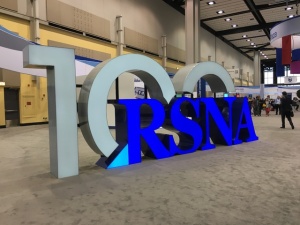By Gus Iversen, Lauren Dubinsky, and John W. Mitchell
Kicking off on Sunday and gaining steam through the early part of the week, RSNA attendees have by now gotten more than a taste of what's happening in the world of radiology — and the HCB News team was alongside them taking notes.
First off, it's necessary — if not a little sobering — to acknowledge that this year's meeting has not turned the industry on its head. Health reform remains the key catalyst for hospital decision makers, and it's been that way for several years now.



Ad Statistics
Times Displayed: 48055
Times Visited: 1477 MIT labs, experts in Multi-Vendor component level repair of: MRI Coils, RF amplifiers, Gradient Amplifiers Contrast Media Injectors. System repairs, sub-assembly repairs, component level repairs, refurbish/calibrate. info@mitlabsusa.com/+1 (305) 470-8013
But what draws over 50,000 radiology professionals (last year it was 56,026 to be exact) to Chicago in the early stages of the winter season is not a desire to reacquaint themselves with what remains the same. It's an opportunity to find out about the latest technology and research taking place in the industry, to form new partnerships, and to discuss the problems and solutions that are shaping radiology.
We divided and conquered the main attractions (announcements, presentations, and exhibition booths) and have come up with the HCB News top 10 takeaways from RSNA 2015:
10) Tomosynthesis — No longer just for breast imaging
While tomography has largely been displaced by CT for many indications, X-ray tomosynthesis, in turn, is poised to
raise the bar on many of those CT exams. GE Healthcare is among the OEMs getting an early jump on this technology with an application called VolumeRAD which is proving to be very useful in the orthopedic segment. Shimadzu has also arrived early on the scene, and other companies (including Canon USA) mentioned big-picture plans to get involved eventually.
Once the reimbursement is there for X-ray tomosynthesis we expect this trend to gain greater momentum and have a big impact on some of the more common exams, like chest X-ray.
9) Ethics, computer-learning, and the FDA
Computer learning has massive potential for health care, but it presents regulatory challenges. How will the FDA, and other agencies, be able to validate systems to ensure they are learning
correctly? And what would correct learning look like, anyway?
It's an abstract concept for an agency that has traditionally dealt in comparatively finite terms.
The
partnership between IBM Watson and Merge Healthcare is a perfect example of the promise computer learning holds — but to what extent can you give artificial intelligence a license to make medical decisions? The thought alone may be enough to make you want to never watch
The Matrix again.

